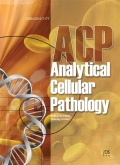Authors: Lucci, Maria Antonietta | Orlandi, Rosaria | Triulzi, Tiziana | Tagliabue, Elda | Balsari, Andrea | Villa-Moruzzi, Emma
Article Type:
Research Article
Abstract:
Background: HER2-overexpression promotes malignancy by modulating signalling molecules, which include PTPs/DSPs (protein tyrosine and dual-specificity phosphatases). Our aim was to identify PTPs/DSPs displaying HER2-associated expression alterations. Methods: HER2 activity was modulated in MDA-MB-453 cells and PTPs/DSPs expression was analysed with a DNA oligoarray, by RT-PCR and immunoblotting. Two public breast tumor datasets were analysed to identify PTPs/DSPs differentially expressed in HER2-positive tumors. Results: In cells (1) HER2-inhibition up-regulated 4 PTPs (PTPRA, PTPRK, PTPN11, PTPN18) and 11 DSPs (7 MKPs [MAP Kinase Phosphatases], 2 PTP4, 2 MTMRs [Myotubularin related phosphatases]) and down-regulated 7 DSPs (2 MKPs, 2 MTMRs, CDKN3,
…PTEN, CDC25C); (2) HER2-activation with EGF affected 10 DSPs (5 MKPs, 2 MTMRs, PTP4A1, CDKN3, CDC25B) and PTPN13; 8 DSPs were found in both groups. Furthermore, 7 PTPs/DSPs displayed also altered protein level. Analysis of 2 breast cancer datasets identified 6 differentially expressed DSPs: DUSP6, strongly up-regulated in both datasets; DUSP10 and CDC25B, up-regulated; PTP4A2, CDC14A and MTMR11 down-regulated in one dataset. Conclusions: Several DSPs, mainly MKPs and, unexpectedly, MTMRs, were altered following HER2-modulation in cells and 3 DSPs (DUSP6, CDC25B and MTMR11) were altered in both cells and tumors. Among these, DUSP6, strongly up-regulated in HER2-positive tumors, would deserve further investigation as tumor marker or potential therapy target.
Show more
Keywords: Tyrosine phosphatases, phosphorylation, HER2, breast cancer, array analysis
DOI: 10.3233/CLO-2010-0520
Citation: Analytical Cellular Pathology,
vol. 32, no. 5-6, pp. 361-372, 2010
Price: EUR 27.50





